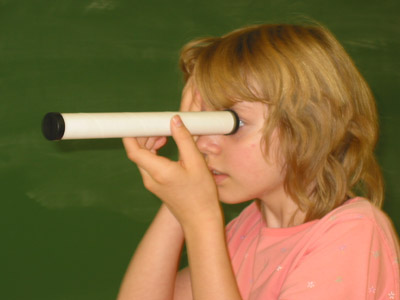
Instructions for:
Spectroscope
The Spectroscope included in the Zoo is a simplified version of a very useful and important piece of scientific equipment. A spectroscope is used to determine the atomic makeup of a visible source of light; a star, planet, or light bulb for instance.
White light is actually made up of many different colors of light; red, blue, green, yellow – all the colors imaginable really (except black, which is defined as the absence of light). A spectroscope, much like a glass prism, splits the white light into all of its component colors, pointing each colored beam in a different direction. When you point the spectroscope at a light source (a fluorescent light bulb works best), you see an assortment of narrow bands of colored light – these are the individual components of the white light that enters the spectroscope.
The usefulness of the spectroscope comes when considering the types of light emitted by different elements. Each element, when caused to emit light (through excitation of some kind – electrification is an example, like a fluorescent bulb), emits a signature spectrum; a set of wavelengths specific to that element alone. When we look at a star through a spectroscope, we can analyze the colored bands that appear. If the bands from the star match those of a known atomic spectrum, hydrogen for example, we can conclude that the star contains hydrogen. The spectroscope has been crucial in determining the types and concentrations of elements present in the solar system and the whole universe. In the classroom, it can be used to demonstrate a difference between light sources.
A fluorescent bulb contains a mixture of gases (often argon and mercury) that, when excited by electricity, fool the eye into thinking that pure white light is being produced. In fact, each of these gases produce a signature spectrum of wavelengths, which all excite a special coating on the inside of the glass tube (a phosphor), which produces the white light we see. Pure white light, when viewed through a spectroscope, would reveal a spectrum that looked like one wide band, like a rainbow, encompassing all colors. When the "white" light from the fluorescent bulb passes through a spectroscope, it is split into its component wavelengths, each attributable to a certain gas inside the bulb. These spectra usually consist of a few easily distinguished colors. Try looking at a few different bulbs to determine if their contents are the same or different. Also, try looking at a normal incandescent bulb, what is different?
Questions for Students / Items of Interest:
Copyright 2004 Straley/Pinney - The University of Kentucky Physics Petting Zoo